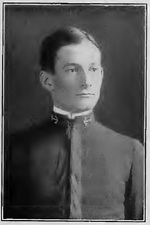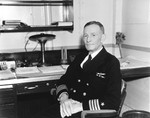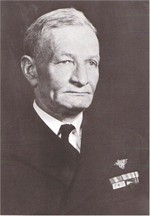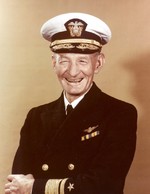John McCain
| Surname | McCain |
| Given Name | John |
| Born | 9 Aug 1884 |
| Died | 6 Sep 1945 |
| Country | United States |
| Category | Military-Sea |
| Gender | Male |
Contributor: David Stubblebine
ww2dbaseJohn Sidney McCain, Sr. was part of a long unbroken line of McCains in the American military - starting with a direct ancestor on the staff of General George Washington down to two great-grandsons currently (2009) serving in the US Navy and Marines. World War II was also a family affair; John S. McCain, Sr. rose to the rank of Vice-Admiral in the US Navy, his brother, William Alexander "Bill" McCain, was a Brigadier General in the US Army, and his son, John S. McCain, Jr., was a Commander in the US Navy commanding a submarine.
ww2dbaseJohn McCain was born on the family's former plantation in Teoc (Carroll County), Mississippi. As was the family custom, the first-born (Bill) went to the US Military Academy at West Point. Sidney, as he was called at home, was under no such expectation as the third-born, but he wanted to follow his father and brother to West Point nonetheless. Brother Bill encouraged Sidney to take the entrance exams for the Naval Academy as practice for the West Point exams. He passed the exams and won an appointment to Annapolis.
ww2dbaseMcCain graduated from the Academy in 1909, 79th in a class of 116. Teddy Roosevelt's two-year world cruise of the Great White Fleet was in its final stages and McCain served aboard the Battleship Connecticut on her final legs of the cruise. As the US entered the First World War, McCain was serving aboard the flagship of the Pacific Fleet, the armored cruiser USS San Diego. The cruiser was assigned escort duties in the U-Boat infested North Atlantic. In May 1918, McCain was transferred to the Bureau of Navigation and two months later, San Diego was sunk.
ww2dbase"Slew" McCain, as he was known since the Academy, served aboard battleships between the wars where he gained a reputation as a courageous natural leader of men. These traits led to his first command, the cargo transport Sirius. In 1936, at the age of 52, he became one of the oldest men, before or since, to achieve the status of Naval Aviator. Within a year he took command of the aircraft carrier Ranger, a post he held for two years from 1937 to 1939. This was a period that saw tremendous development in military aviation generally and carrier aviation in particular. Ranger played a prominent role in the creation of the carrier tactics that would prove essential in the inevitable war on the horizon. Early in 1941, McCain was promoted to Rear Admiral in command of Aircraft Scouting Force of the Atlantic Fleet.
ww2dbaseAfter Japan attacked Pearl Harbor, McCain was appointed as Commander, Aircraft, South Pacific in May 1942 commanding all land-based Allied air operations in the South Pacific area supporting the Solomon Islands. Aircraft under McCain's command, including the Cactus Air Force located at Guadalcanal's Henderson Field, were key in supporting the successful effort to defend Guadalcanal from Japanese efforts to retake the island during this time. He also drew criticism for some of the operational setbacks in the Guadalcanal campaign.
ww2dbaseIn October 1942, McCain went to Washington, D.C. as head of the Bureau of Aeronautics. In August 1943, he was promoted again to Vice-Admiral and was appointed as Deputy Chief of Naval Operations for Air.
ww2dbaseIn August 1944 McCain returned to the Pacific and was given command of a carrier group in VAdm Marc Mitscher's Fast Carrier Task Force. McCain participated in the Marianas campaign, including the Battle of the Philippine Sea, and the beginning of the Philippines campaign. After the cruisers Canberra and Houston were torpedoed off Taiwan in mid-October, McCain sailed his Task Group between the crippled ships and the attacking Japanese force. This allowed the cruisers to safely withdraw and scattered the Japanese ships. This action won McCain the Navy Cross for heroism and leadership.
ww2dbaseDuring the Battle of Leyte Gulf, RAdm Clifton "Ziggy" Sprague's Task Unit Taffy 3 of escort carriers and light escorts were under the guns of Kurita's vastly superior Center Force. McCain had been ordered to take his Task Group out of action for some well-earned rest, but he turned his ships toward Sprague's calls for help even before any orders to do so. McCain was still too far away for his planes to help Sprague and still make it back to their carriers, but McCain anguished over the radio calls for assistance. With some trepidation, he quietly gave the order, "Turn into the wind" (the first step in the process to launch aircraft). Most of the planes from McCain's Task Group landed on shore bases or on other carriers after joining the battle to help Taffy 3. Although the attack did little damage, it strengthened Kurita's decision to retire.
ww2dbaseOn 30 October 1944, McCain relieved Mitscher as commander of Task Group 38 and the two would alternate command of the Fast Carrier Task Group through to the end of the war. In McCain's first three months of command, he earned his place in history by aggressively pursuing the Japanese around the Philippines Islands and the South China Sea. The sortie into the South China Sea via the northern passage spelled doom for the Japanese war effort as it slammed the door on the supply of oil and rubber from Singapore. On one day, 12 January 1945, Task Force 38 sunk over 40 Japanese combat ships and merchant ships in Operation Gratitude, concentrated raids along the coast of Indo-China.
ww2dbaseBy war's end in August 1945, the stress of combat command had worn McCain down to only 100 pounds. He requested leave to go home and recuperate, but Adm Halsey insisted that he be present at the Japanese surrender ceremony in Tokyo Bay on September 2, 1945. Departing immediately after the ceremony, McCain flew straight home for a rest. He made the day-and-a-half island hopping flight in the back of a Navy pursuit plane. His wife met him at the Coronado Naval Air Station and, at his welcome-home party, he sat down and quietly died. He had been home from the war for less than half a day.
ww2dbaseIn 1949, McCain was promoted to full admiral posthumously by act of Congress. Secretary of the Navy James Forrestal said of McCain: "He was a fighting man all the way through." Authors would later liken McCain to Jeb Stuart and George Patton for his successful aggressive "Attack, Attack, Attack" attitude.
ww2dbaseMcCain's son, John Sidney "Jack" McCain, Jr., also graduated from the Naval Academy. He commanded US submarines Gunnel and Dentuda in World War II and accompanied his father at the surrender ceremony - the last time they would see each other. Jack McCain would become a full Admiral in command of the Pacific Fleet during the Vietnam conflict. Slew and Jack McCain were the only father and son pair to become full four-star admirals in US Naval history.
ww2dbaseJack McCain's son, John S. McCain III, also graduated from the Naval Academy, flew carrier based fighters in Vietnam, spent five years as a POW in North Vietnam, became a US Senator from Arizona, and was the Republican Party's candidate for President in 2008.
ww2dbaseAs of 2008, John S. McCain IV is attending the US Naval Academy at Annapolis.
ww2dbaseJohn S. McCain's Awards
- Navy Cross
- Navy Distinguished Service Medal with 2 Gold Stars
- Mexican Service Medal
- World War I Victory Medal with bronze star
- American Defense Service Medal with "Escort" clasp
- American Campaign Medal
- Asiatic-Pacific Campaign Medal
- World War II Victory Medal
- Navy Occupation Service Medal with "Asia" clasp (posthumous)
ww2dbaseJohn S. McCain's Navy Cross Citation:
ww2dbaseSources: Wikipedia; Arlington National Cemetery; USS John S McCain.
Last Major Revision: Mar 2009
John McCain Interactive Map
Photographs
 |  |  |  |
John McCain Timeline
| 9 Aug 1884 | John McCain was born. |
| 3 Jun 1937 | Captain John S. McCain, Sr. relieved Captain Bellinger as commanding officer of USS Ranger |
| 6 Jun 1939 | Captain Ralph Wood relieved Captain McCain as commanding officer of USS Ranger. |
| 20 May 1942 | US Navy Rear Admiral John S. McCain was named Commander, Air, South Pacific; in this position he directed operations of tender-based and land-based aircraft in the South Pacific. |
| 16 Jul 1942 | US Navy Vice Admiral Robert Ghormley named Rear Admiral John McCain the commanding officer of land-based air groups for the upcoming operations in the Solomon Islands. |
| 18 Dec 1944 | Many ships from the United States Third Fleet, Task Force 38 sailed into Typhoon Cobra in the Philippine Sea. Three destroyers and 790 men were lost. |
| 18 May 1945 | Vice Admiral John S. McCain, Sr. of US Navy Carrier Task Force 2 broke his flag aboard USS Shangri-La at Ulithi Atoll, Caroline Islands. |
| 28 May 1945 | Vice Admiral John S. McCain, Sr. relieved Marc Mitscher as the commanding officer of US Navy Task Force 38; USS Shangri-La remained McCain's flagship. |
| 4 Jun 1945 | Many ships from the United States Third Fleet, primarily Task Groups 38.1 and 30.8 sailed into Typhoon Connie south of Japan. No ships were lost but 7 men lost their lives. |
| 15 Jun 1945 | A United States Navy Court of Inquiry was convened aboard USS New Mexico in San Pedro Bay, Leyte to investigate what led 76 ships to sail into Typhoon Connie ten days before. Responsibility was placed squarely on Admiral William Halsey and Vice-Admiral John McCain, although no action was taken against Halsey. |
| 6 Sep 1945 | John McCain passed away from a heart attack at his home in Coronado, California, United States. |
Please consider supporting us on Patreon. Even $1 per month will go a long way! Thank you. Please help us spread the word: Stay updated with WW2DB: |
Visitor Submitted Comments
28 Dec 2013 01:08:36 PM
To the bravest NAVAL AVIATORS OF OUR FORCES OF WWII.
AS A RETIRED NAVAL AIR CREWMAN. I HAVE HAD THE PLEASURE OF MEETING SENATOR WHEN HE WAS A NAVAL AVIATOR. A GREAT BRAVE LEADER AND AQUANTANCE
14 Oct 2017 07:52:05 AM
thank u so much i needed this for a project and this site has a lot of info i need i am very greatfull
25 Aug 2018 09:13:37 AM
A very brave man with Integrity and high morale values. Condolence to the family and our prayer's too.
Palma's
All visitor submitted comments are opinions of those making the submissions and do not reflect views of WW2DB.
» Mariana Islands Campaign and the Great Turkey Shoot
» Philippines Campaign, Phase 1, the Leyte Campaign
» Typhoon Cobra
» Raid into the South China Sea
» Typhoon Connie
» Japan's Surrender
Ship(s) Served:
» Hancock
» Ranger
» Shangri-La
- » 1,167 biographies
- » 337 events
- » 44,617 timeline entries
- » 1,244 ships
- » 350 aircraft models
- » 207 vehicle models
- » 376 weapon models
- » 123 historical documents
- » 261 facilities
- » 470 book reviews
- » 28,516 photos
- » 365 maps
Captain Henry P. Jim Crowe, Guadalcanal, 13 Jan 1943
Please consider supporting us on Patreon. Even $1 a month will go a long way. Thank you!
Or, please support us by purchasing some WW2DB merchandise at TeeSpring, Thank you!
7 Sep 2011 03:12:18 AM
Awesome article, very informative!